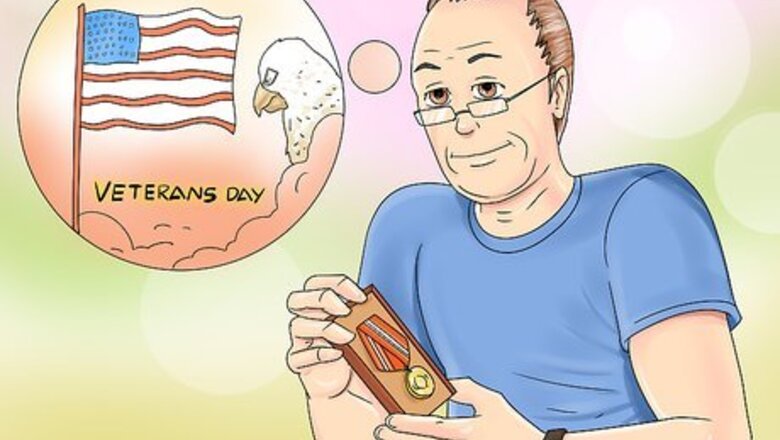
views
Basic Guidelines
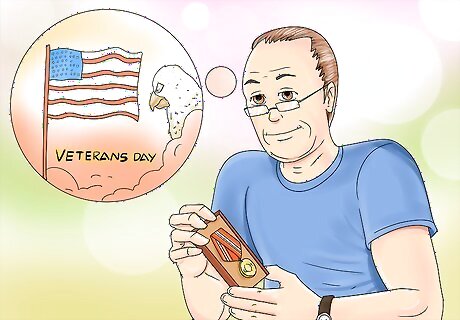
Know when to wear your medals. Veterans, retirees, and active service members can wear military medals and awards on their civilian clothes during events and gatherings with a military theme. This can include military-oriented days of celebration, like Veterans Day and Memorial Day in the United States or Remembrance Day in Canada. Other ceremonial events that you can wear medals at include parades, military presentations, general veterans or military meetings, and funerals. You should only wear medals on civilian clothes when those clothes are still formal attire. Do not wear medals on casual civilian clothes, even during a military event.
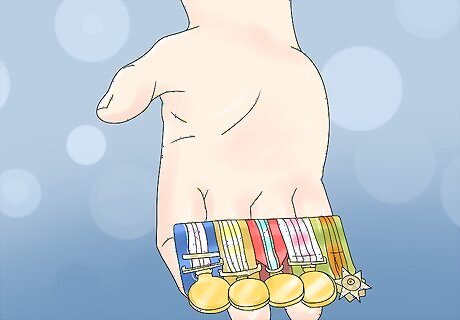
Consider the options. You can wear your full size medals, miniature medals, or lapel pins. Each option can be appropriate. Enameled lapel pins represent a single medal or decoration. In the United States, there are lapel pins that represent every medal and many award ribbons. Usually, you only wear one lapel pin, and that pin can represent either your highest award or an award that has special meaning to you. Lapel pins are only worn on the lapel of a blazer. For more formal attire, full size or miniature medals are usually more appropriate. Each full size medal has an equivalent miniature medal. Miniature medals create a less cluttered appearance, but the choice between full size and miniature medals is entirely a personal one. While it is not a rule, miniature medals are usually worn during very formal events, especially those held in the evening and requiring full evening dress or dinner dress. Full size medals are most typically worn on morning dress or formal daytime attire.
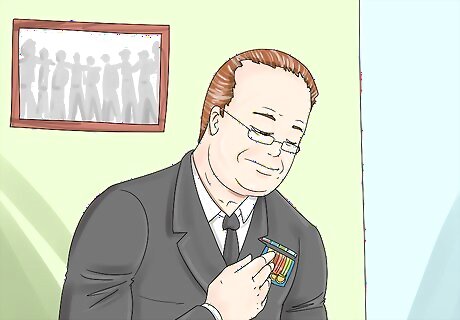
Wear official medals on the left, using a metal bar. Your medals should be worn over the left lapel or the left breast pocket of a formal jacket or coat. Medals are mounted on a metal holding bar or bar brooch, and that bar is attached to the lapel. The center of the holding bar should be parallel to the ground. The most senior medal should be on the right side of the bar in the position furthest away from the left shoulder. The remaining medals should be worn in order of seniority, with the least senior medal on the left side of the bar, nearest the left shoulder. Commemorative or nonofficial awards, when worn, should be placed on the right side. You can only wear one row of medals. The row should not extend past the center of the body or the seam of the left arm sleeve. Note that you should not wear a pocket handkerchief when wearing your medals.

Only wear your own medals. Regardless of the occasion, you should only wear medals that were awarded to you. Never wear medals or awards that were granted to another person, even if that person was a close relative.
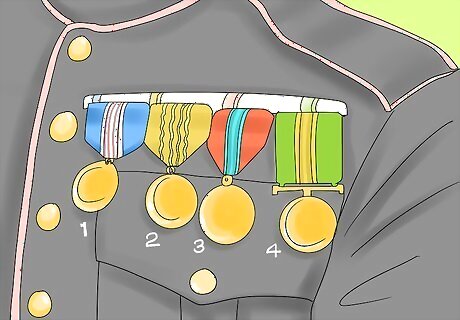
Limit the number of medals. There is no strict rule governing the number of medals to be worn, but as a general guideline, you should try to limit the number to an amount that can be placed on the holding bar without overlapping. Typically, this means wearing no more than five medals side-by-side. If you have more medals than you are permitted to wear based on the guidelines outlined for each specific style of dress, wear the orders and decorations that are the most senior or advanced. On rare occasions, you may need to wear more medals and may need to let them overlap. When overlapping medals, the furthest medal on the left should be at the bottom, with each medal to the right progressively and slightly overlapping the one before it. The right medal, which is also the most senior, should be completely visible.
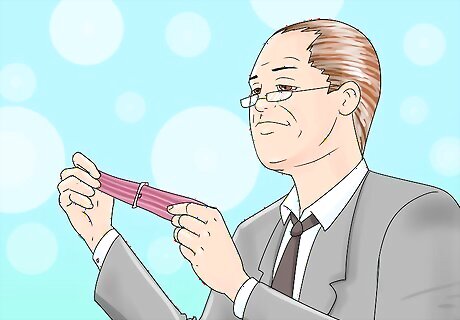
Keep the length of ribbons in check, as needed. The length of the ribbons attached to your medals will need to vary for each medal since each medal is of a different height. The overall length when measured from the top of the ribbon to the bottom of the medal should be 4 inches (10 cm), however. The bottom edge of each medal should be aligned with the other medals. Run the medal ribbon through the ring or clasp on the medal. This clasp should be in the middle of the ribbon. Place the doubled ribbon over the top of the mounting bar, then back down through the slot. Sew the back portion of the ribbon to the bar using the stitch holes provided.
Specific Guidelines
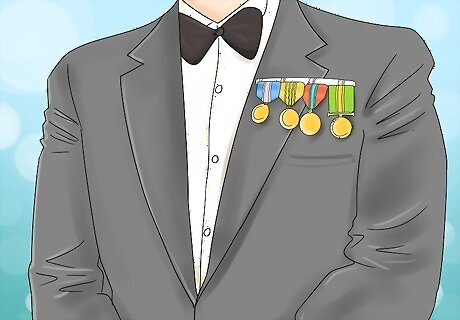
Wear your medals with standard black tie attire. In this case, black tie attire could also be referred to as dinner attire. It's the type of formal attire used for most ceremonies and events, and you can wear most of your medals with this type of attire. Place any medals, badges of orders, or decorations on a metal bar placed over the left lapel of your jacket. You can wear one star on the left breast of the jacket, as well. If you have one, you can wear one neck badge suspended by a miniature ribbon. The badge should fall out just below a bow tie or below the knot of a long tie.
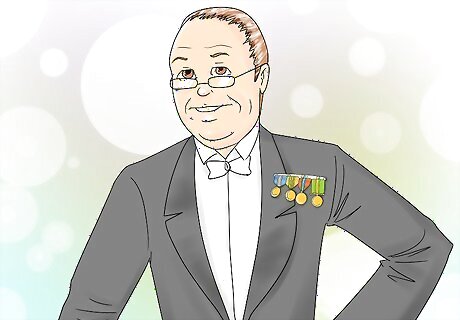
Arrange the medals appropriately for white tie attire. White tie apparel, also known as evening dress, is the most formal of civilian attire. Since this attire is only worn for very special occasions, you can wear more of your medals with it than you can with standard black tie attire. Wear up to four stars on the left breast of your tailcoat. Wear any miniature medals, decorations, and badges of orders on a metal bar positioned on the left lapel of the coat. If desired, you can wear one neck badge suspended on a miniature ribbon of an order below your bow tie. If you have a broad riband sash or shortened riband, wear it over the appropriate shoulder designated by the type of sash. Keep it in between the waistcoat and tailcoat.
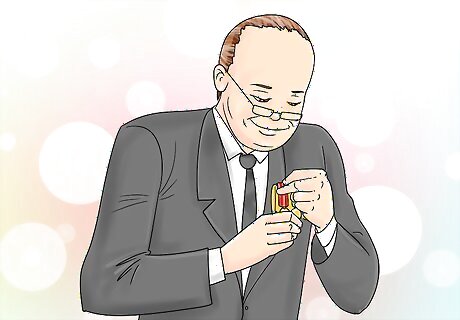
Know the proper way to arrange medals on morning dress attire. Morning dress is the most casual civilian attire you can wear your medals with. This dress style includes any suit or clothing you would wear to formal daytime events. Medals are rarely worn with morning dress, but there are times when the person organizing a daytime event will specify that you should wear your medals. As with other styles of dress, wear your medals, decorations, and badges of orders on a metal bar placed over the left lapel of your jacket. You can place up to four stars on the left breast of the jacket, as well. When applicable, you can suspend one neck badge on a full-width ribbon. The ribbon should be worn under the shirt collar.
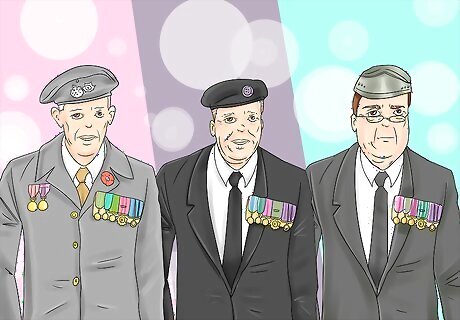
Understand the differences between cultures. Most English-speaking countries, including the United States, Canada, and the United Kingdom, follow the guidelines presented here. Be aware that protocol can vary in different countries or cultures, though. Always check with an official veterans' affairs resource in your country to verify specific dress procedures, especially if you have any doubt or special concerns. Evening, dinner, and morning attire are formal enough throughout North America and the United Kingdom, but in other parts of Europe, only full evening attire (white tie) offers a formal enough occasion to wear your medals. This is typically true in Italy, France, Germany, and Spain.


















Comments
0 comment